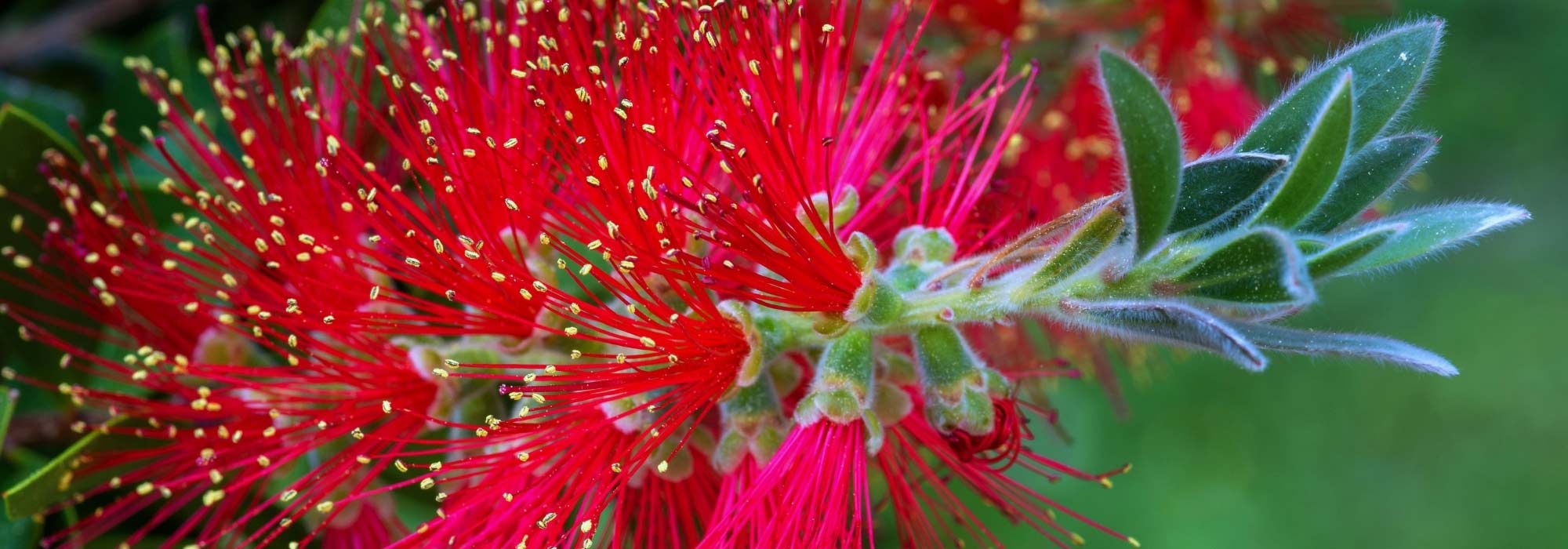
How to choose a Callistemon?
Our buying guide to find the ideal variety
Contents
Callistemons are wonderful evergreen bushes. Mostly native to Australia, they have an original flowering that has earned them the common name Bottlebrush. Indeed, their numerous colourful flowers have a characteristic brush-like shape, which stands out strikingly against the lanceolate, dark green or greyish foliage. Most Callistemons have a bushy habit, sometimes rigid and sometimes arching, depending on the variety. They are not very hardy subjects, so it is important to choose the ideal Bottlebrush according to your region’s climate, the nature of your soil, and the location you want to reserve for it in the garden: in a bed, isolated, or in a lovely pot on your terrace. To help you navigate the different Bottlebrushes in our collection, we offer you our buying guide.
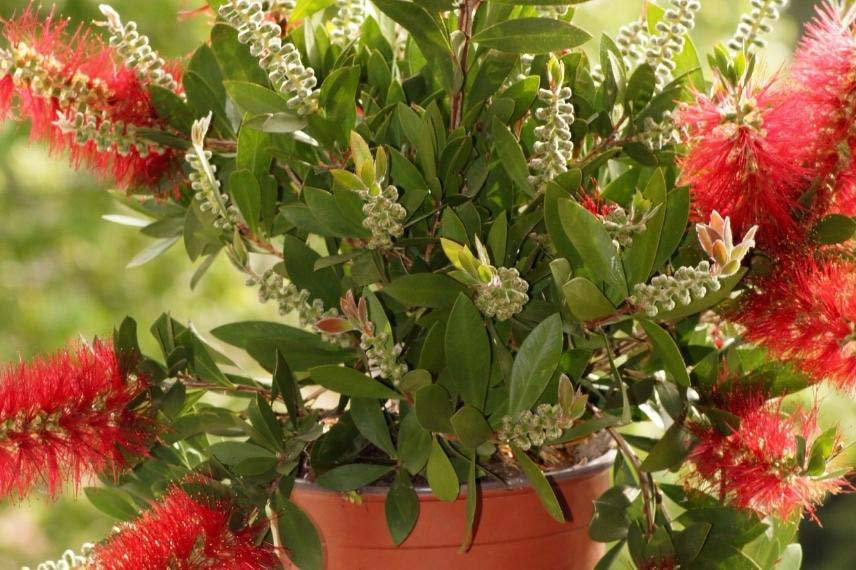
Choosing your Bottlebrush should take various criteria into account
According to the size of the bush
Callistemons take the form of bushy bushes with heights ranging from 1 m for the more compact varieties to over 7 m for those forming small trees. The height at ripeness is therefore an important criterion to consider for their future placement in your garden.
Small varieties: up to 1.50 m tall
The rare small Callistemons are suitable for planting at the front of borders, paired with small bushes and perennials in a mild climate. Floriferous and decorative, they can also be grown in pots or containers on a sunny terrace or balcony. Ideal for small spaces and valuable for this unusual use among Bottlebrushes, you can confidently choose:
Medium varieties: 1.80 m to 2 m tall
These bushes are ideal subjects for planting in hedges, preferably free-form to allow their natural silhouette to express itself with flair. They can also be planted in beautiful structured borders alongside both evergreen and deciduous plants, varying the colours of the flowers:
- The Callistemon (x) laevis
- The Callistemon viminalis ‘Hot Pink’
- The Callistemon viminalis ‘Captain Cook’
Large varieties: 2.50 m to 3 m tall
These bushy subjects are ideally planted in large windbreak hedges, for example, by the sea or in windy regions. Elsewhere, they will form screens to isolate the garden from the neighbours, accompanied by other large-growing evergreen trees and bushes:
- The Callistemon citrinus ‘Splendens’
- The Callistemon rigidus
- The Callistemon citrinus ‘Burgundy’
- The Callistemon citrinus ‘Mauve Mist’
- The Callistemon viminalis ‘Bright Pink’
The small tree: over 7 m
- The Callistemon viminalis is a small-growing tree, well-suited to compact gardens that require a bit of verticality. It reaches an adult size between 7 and 10 m with a spread of 3 m and is covered in spring with bright red bottlebrush flowers that stand out against the lush green foliage. It naturally has a lovely weeping habit, accentuated when in flower.
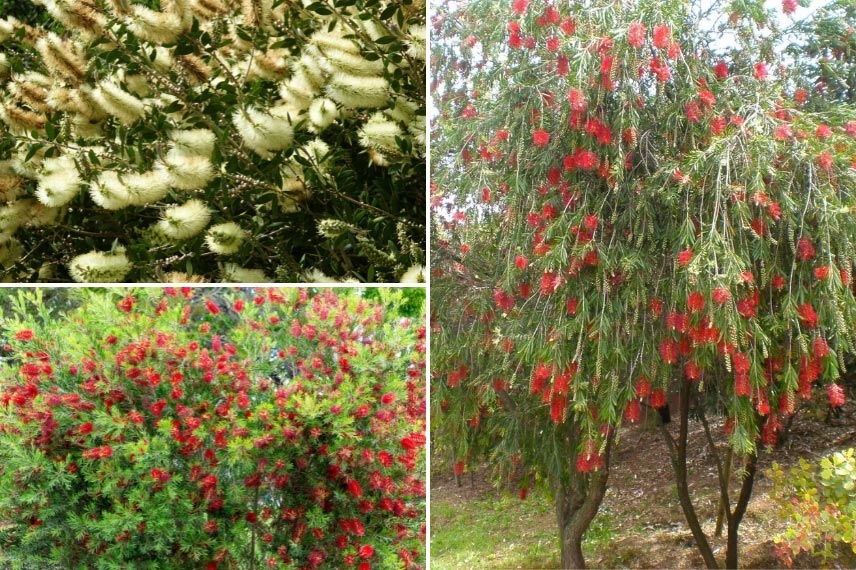 Callistemon citrinus ‘Albus’, Callistemon rigidus and Callistemon viminalis
Callistemon citrinus ‘Albus’, Callistemon rigidus and Callistemon viminalis
According to the colour of the flowers
Bottlebrushes mostly have flowering in shades of bright reds or pinks. Melliferous and nectariferous, these flowers are a delight for many insects, butterflies, and birds.
Red Callistemons
For those who appreciate bold colours in the garden, these Bottlebrushes are quite suitable. Their vibrant flowers highlight the subjects with grey-green foliage, which will become more discreet once they have finished flowering:
- Callistemon masotti ‘Mini Red’
- Callistemon (x) laevis
- Callistemon viminalis ‘Captain Cook’
- Callistemon citrinus ‘Splendens’
- Callistemon rigidus
- Callistemon viminalis
Pink Callistemons
Softer, powdery colours, to be paired with violet-mauve tones, pale pinks, and greyish foliage:
- Callistemon viminalis ‘Hot Pink’
- Callistemon citrinus ‘Burgundy’
- Callistemon citrinus ‘Mauve Mist’
- Callistemon viminalis ‘Bright Pink’
White Callistemons
Less common among these bushes, the white colour of certain varieties allows for soft or tangy harmonies:
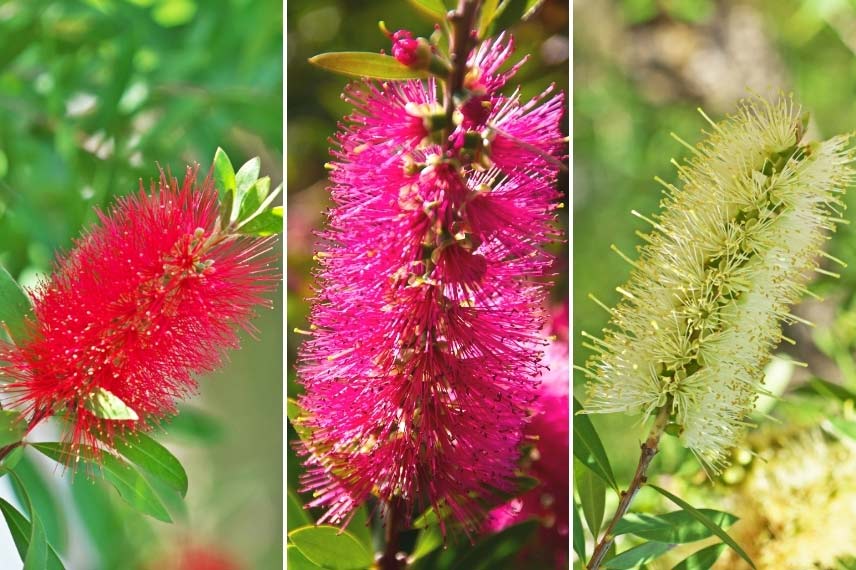 Red, pink, or white bottlebrushes</caption]
Red, pink, or white bottlebrushes</caption]
Discover other Callistemon
View all →Available in 2 sizes
Available in 1 sizes
Available in 2 sizes
Available in 1 sizes
Available in 1 sizes
Available in 2 sizes
Available in 2 sizes
Available in 2 sizes
Available in 1 sizes
Available in 2 sizes
According to hardiness
Callistemon is a bush that enjoys sunlight and warmth, thriving in well-drained, fertile soil, preferably cool, neutral, or acidic, which corresponds to sandy soils. However, it can withstand periods of drought once well-rooted. For exposure, it should be placed in a sunny spot or partial shade, although flowering will be less abundant in the latter case. Native to the south-east of Australia, bottlebrushes are not suited to cold conditions. A few varieties are resistant down to -10° C, but some are less hardy. If you are drawn to these unique bushes, this hardiness criterion is crucial in your selection.
Callistemons resistant down to -5 °C
These varieties can withstand temperatures down to -5° C, or even -7° C for short periods, before a welcome warming. They appreciate heat and full sun. In colder regions, they should be grown in pots and brought indoors for winter:
- Callistemon (x) laevis
- Callistemon citrinus ‘Splendens’
- Callistemon viminalis ‘Captain Cook’
- Callistemon viminalis ‘Hot Pink’
- Callistemon citrinus ‘Albus’
- Callistemon citrinus ‘Burgundy’
- Callistemon citrinus ‘Mauve Mist’
- Callistemon masotti ‘Mini Red’
- Callistemon salignus
- Callistemon viminalis
- Callistemon viminalis ‘Bright Pink’
Callistemon resistant down to -10 °C
- Callistemon rigidus: Somewhat hardier, this variety can withstand temperatures down to -10° C, and exceptionally down to -12° C. This species is also one of the most tolerant regarding soil cultivation conditions and the most resistant to summer drought.
→ For more information, check our sheet: Callistemon, Bottlebrush: how to protect it from the cold in winter?
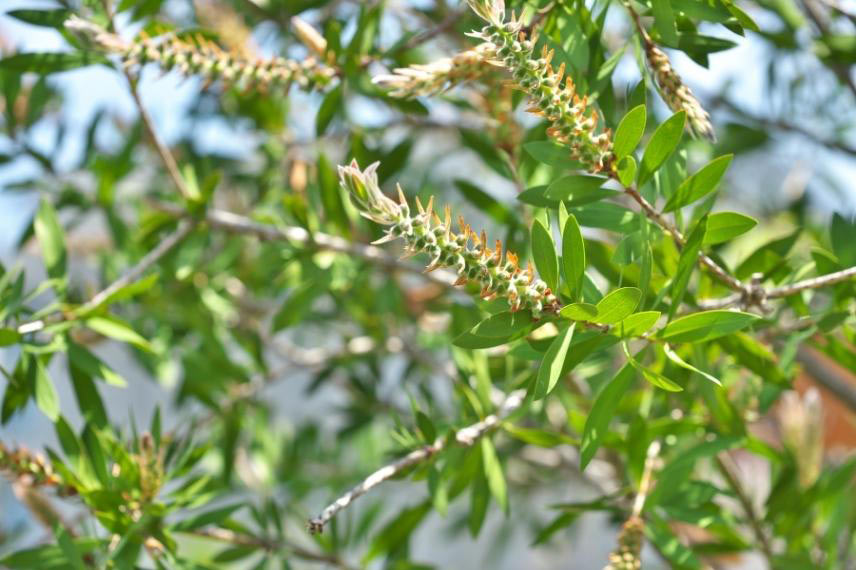 Bottlebrushes are bushes that are not very cold-resistant
Bottlebrushes are bushes that are not very cold-resistant
Read also
How to pair Callistemon?According to the flowering period
The choice of your Callistemon may also depend on the time of year when it will be in flower, so that its colours can best match the other blooms in your garden. The earliest and most spring-like of them will be the small bush Callistemon masotti ‘Mini Red’, which begins its flowering in march and continues until May. Then, Callistemon rigidus takes over and flowers from May to June, during which time the Callistemon citrinus ‘Splendens’ and Callistemon citrinus ‘Albus’ start to display their brushes until August.
The majority of Bottlebrushes flower for the first time in May-June and regain colour from august until the end of September, depending on the climate creating favourable conditions. In fact, in their natural habitat, this flowering occurs in successive waves 3 to 4 times a year. These include:
According to use in the garden
Callistemons can be used in a variety of situations: in borders, as hedges, as standalone plants, or in large pots. Their evergreen foliage remains decorative throughout the year, much to the delight of gardeners:
- at the back of borders, opt for medium-sized bottlebrushes such as Callistemon (x) laevis, viminalis ‘Hot Pink’ or viminalis ‘Captain Cook’ alongside other evergreen shrubs like Laurier-tin, Grevillea, or deciduous ones like Vitex agnus castus;
- at the edge of borders, prefer compact varieties such as Callistemon masotti ‘Mini Red’, Callistemon citrinus ‘Albus’ or Callistemon salignus, which pair well with groundcovers or low perennials;
- in hedges with Pittosporum or oleanders, choose larger specimens like Callistemon citrinus ‘Splendens’ or ‘Burgundy’, or even Callistemon citrinus ‘Mauve Mist’ or viminalis ‘Bright Pink’. The Callistemon rigidus, with its upright branches, is one of the most resistant to wind and salt spray: it will naturally find its place by the sea, whether pruned or left free;
- as a standalone plant, plant the tall Callistemon viminalis with its lovely trailing habit. Its evergreen leaves will keep it attractive all year round;
- in large pots, the red flowers of the highly decorative Callistemon masotti ‘Mini Red’ will brighten up the terrace, while Callistemon citrinus ‘Albus’ will add a clear and bright note. For pot or container planting, ensure good drainage with clay balls at the bottom of the pot, use mulch to retain moisture during summer watering, and provide regular fertiliser to compensate for the depletion of the compost over the months.
- Subscribe!
- Contents
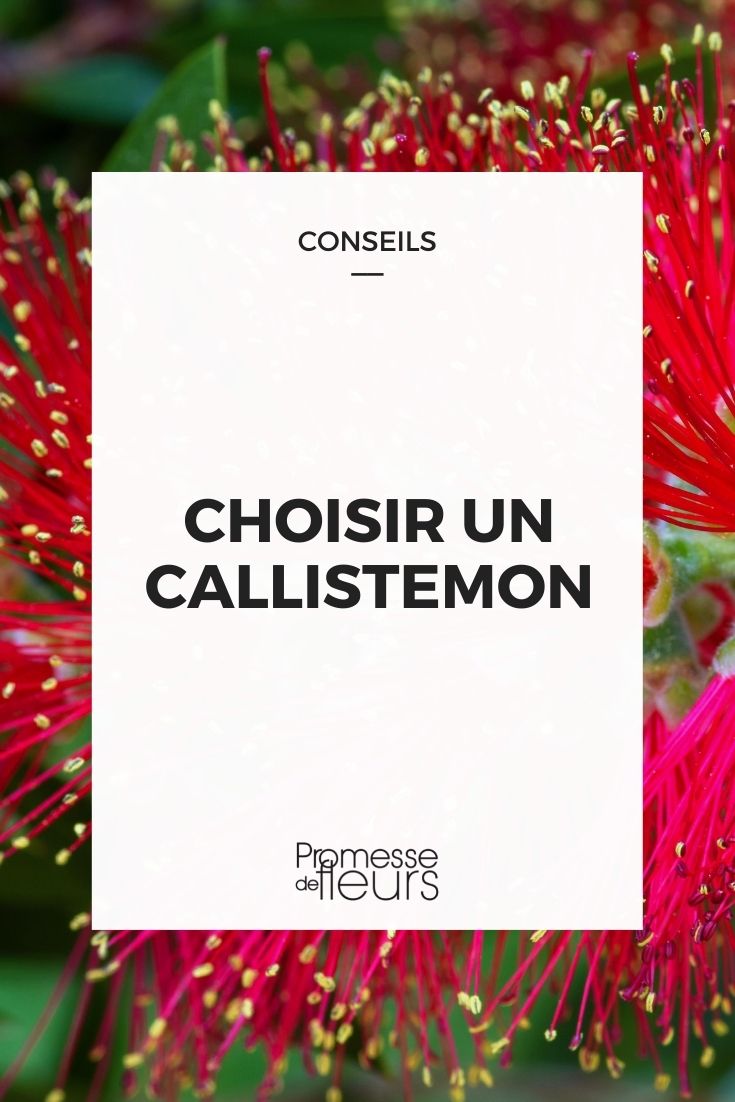

































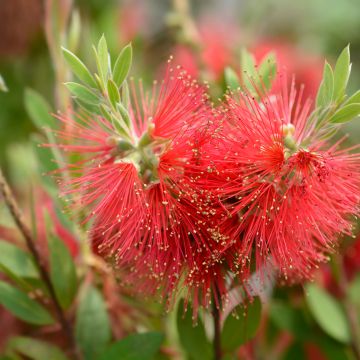
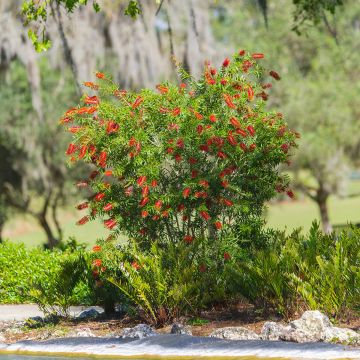
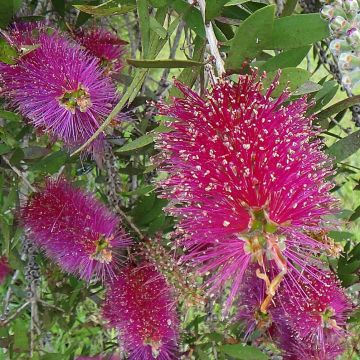
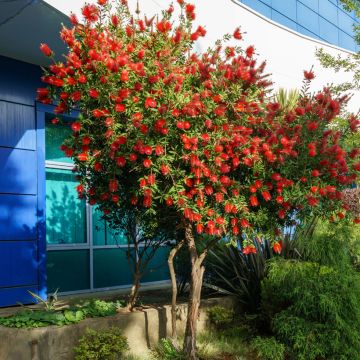
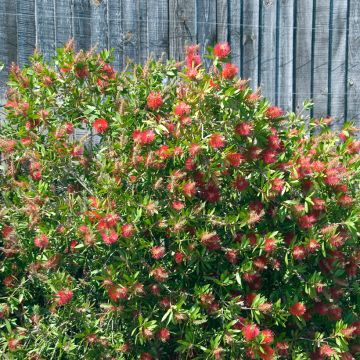
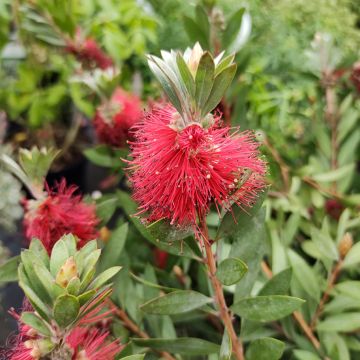
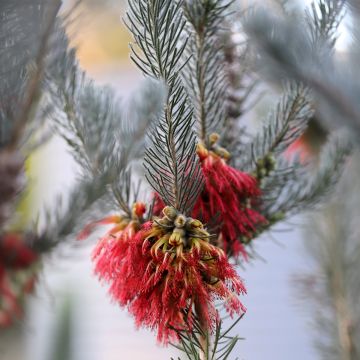

Comments